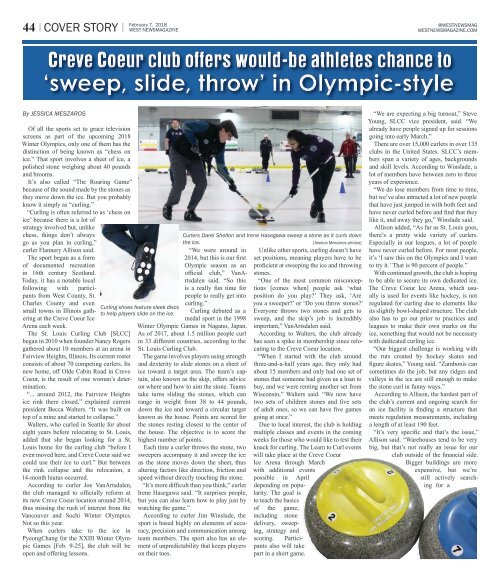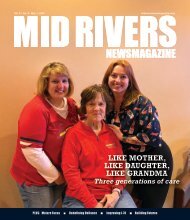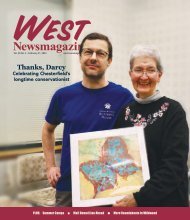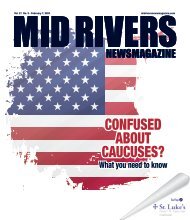West Newsmagazine 2-7-18
Local news, local politics and community events for West St. Louis County Missouri.
Local news, local politics and community events for West St. Louis County Missouri.
You also want an ePaper? Increase the reach of your titles
YUMPU automatically turns print PDFs into web optimized ePapers that Google loves.
44 I COVER STORY I<br />
February 7, 20<strong>18</strong><br />
WEST NEWSMAGAZINE<br />
@WESTNEWSMAG<br />
WESTNEWSMAGAZINE.COM<br />
Creve Coeur club offers would-be athletes chance to<br />
‘sweep, slide, throw’ in Olympic-style<br />
By JESSICA MESZAROS<br />
Of all the sports set to grace television<br />
screens as part of the upcoming 20<strong>18</strong><br />
Winter Olympics, only one of them has the<br />
distinction of being known as “chess on<br />
ice.” That sport involves a sheet of ice, a<br />
polished stone weighing about 40 pounds<br />
and brooms.<br />
It’s also called “The Roaring Game”<br />
because of the sound made by the stones as<br />
they move down the ice. But you probably<br />
know it simply as “curling.”<br />
“Curling is often referred to as ‘chess on<br />
ice’ because there is a lot of<br />
strategy involved but, unlike<br />
chess, things don’t always<br />
go as you plan in curling,”<br />
curler Flannery Allison said.<br />
The sport began as a form<br />
of documented recreation<br />
in 16th century Scotland.<br />
Today, it has a notable local<br />
following with participants<br />
from <strong>West</strong> County, St.<br />
Charles County and even<br />
small towns in Illinois gathering<br />
at the Creve Coeur Ice<br />
Arena each week.<br />
The St. Louis Curling Club [SLCC]<br />
began in 2010 when founder Nancy Rogers<br />
gathered about 10 members at an arena in<br />
Fairview Heights, Illinois. Its current roster<br />
consists of about 70 competing curlers. Its<br />
new home, off Olde Cabin Road in Creve<br />
Coeur, is the result of one woman’s determination.<br />
“... around 2012, the Fairview Heights<br />
ice rink there closed,” explained current<br />
president Becca Walters. “It was built on<br />
top of a mine and started to collapse.”<br />
Walters, who curled in Seattle for about<br />
eight years before relocating to St. Louis,<br />
added that she began looking for a St.<br />
Louis home for the curling club “before I<br />
even moved here, and Creve Coeur said we<br />
could use their ice to curl.” But between<br />
the rink collapse and the relocation, a<br />
14-month hiatus occurred.<br />
According to curler Joe VanArtsdalen,<br />
the club managed to officially reform at<br />
its new Creve Coeur location around 2014,<br />
thus missing the rush of interest from the<br />
Vancouver and Sochi Winter Olympics.<br />
Not so this year.<br />
When curlers take to the ice in<br />
PyeongChang for the XXIII Winter Olympic<br />
Games [Feb. 9-25], the club will be<br />
open and offering lessons.<br />
“We were around in<br />
2014, but this is our first<br />
Olympic season as an<br />
official club,” VanArtsdalen<br />
said. “So this<br />
is a really fun time for<br />
people to really get into<br />
curling.”<br />
Curling debuted as a<br />
medal sport in the 1998<br />
Winter Olympic Games in Nagano, Japan.<br />
As of 2017, about 1.5 million people curl<br />
in 33 different countries, according to the<br />
St. Louis Curling Club.<br />
The game involves players using strength<br />
and dexterity to slide stones on a sheet of<br />
ice toward a target area. The team’s captain,<br />
also known as the skip, offers advice<br />
on where and how to aim the stone. Teams<br />
take turns sliding the stones, which can<br />
range in weight from 38 to 44 pounds,<br />
down the ice and toward a circular target<br />
known as the house. Points are scored for<br />
the stones resting closest to the center of<br />
the house. The objective is to score the<br />
highest number of points.<br />
Each time a curler throws the stone, two<br />
sweepers accompany it and sweep the ice<br />
as the stone moves down the sheet, thus<br />
altering factors like direction, friction and<br />
speed without directly touching the stone.<br />
“It’s more difficult than you think,” curler<br />
Irene Hasegawa said. “It surprises people,<br />
but you can also learn how to play just by<br />
watching the game.”<br />
According to curler Jim Winslade, the<br />
sport is based highly on elements of accuracy,<br />
precision and communication among<br />
team members. The sport also has an element<br />
of unpredictability that keeps players<br />
on their toes.<br />
Curling shoes feature sleek discs<br />
to help players slide on the ice.<br />
Curlers Darel Shelton and Irene Hasegawa sweep a stone as it curls down<br />
the ice.<br />
[Jessica Meszaros photos]<br />
Unlike other sports, curling doesn’t have<br />
set positions, meaning players have to be<br />
proficient at sweeping the ice and throwing<br />
stones.<br />
“One of the most common misconceptions<br />
[comes when] people ask ‘what<br />
position do you play?’ They ask, ‘Are<br />
you a sweeper?’ or ‘Do you throw stones?’<br />
Everyone throws two stones and gets to<br />
sweep, and the skip’s job is incredibly<br />
important,” VanArtsdalen said.<br />
According to Walters, the club already<br />
has seen a spike in membership since relocating<br />
to the Creve Coeur location.<br />
“When I started with the club around<br />
three-and-a-half years ago, they only had<br />
about 15 members and only had one set of<br />
stones that someone had given us a loan to<br />
buy, and we were renting another set from<br />
Wisconsin,” Walters said. “We now have<br />
two sets of children stones and five sets<br />
of adult ones, so we can have five games<br />
going at once.”<br />
Due to local interest, the club is holding<br />
multiple classes and events in the coming<br />
weeks for those who would like to test their<br />
knack for curling. The Learn to Curl events<br />
will take place at the Creve Coeur<br />
Ice Arena through March<br />
with additional events<br />
possible in April<br />
depending on popularity.<br />
The goal is<br />
to teach the basics<br />
of the game,<br />
including stone<br />
delivery, sweeping,<br />
strategy and<br />
scoring. Participants<br />
also will take<br />
part in a short game.<br />
“We are expecting a big turnout,” Steve<br />
Young, SLCC vice president, said. “We<br />
already have people signed up for sessions<br />
going into early March.”<br />
There are over 15,000 curlers in over 135<br />
clubs in the United States. SLCC’s members<br />
span a variety of ages, backgrounds<br />
and skill levels. According to Winslade, a<br />
lot of members have between zero to three<br />
years of experience.<br />
“We do lose members from time to time,<br />
but we’ve also attracted a lot of new people<br />
that have just jumped in with both feet and<br />
have never curled before and find that they<br />
like it, and away they go,” Winslade said.<br />
Allison added, “As far as St. Louis goes,<br />
there’s a pretty wide variety of curlers.<br />
Especially in our leagues, a lot of people<br />
have never curled before. For most people,<br />
it’s ‘I saw this on the Olympics and I want<br />
to try it.’ That is 90 percent of people.”<br />
With continued growth, the club is hoping<br />
to be able to secure its own dedicated ice.<br />
The Creve Coeur Ice Arena, which usually<br />
is used for events like hockey, is not<br />
regulated for curling due to elements like<br />
its slightly bowl-shaped structure. The club<br />
also has to go out prior to practices and<br />
leagues to make their own marks on the<br />
ice, something that would not be necessary<br />
with dedicated curling ice.<br />
“Our biggest challenge is working with<br />
the ruts created by hockey skates and<br />
figure skates,” Young said. “Zambonis can<br />
sometimes do the job, but any ridges and<br />
valleys in the ice are still enough to make<br />
the stone curl in funny ways.”<br />
According to Allison, the hardest part of<br />
the club’s current and ongoing search for<br />
an ice facility is finding a structure that<br />
meets regulation measurements, including<br />
a length of at least 190 feet.<br />
“It’s very specific and that’s the issue,”<br />
Allison said. “Warehouses tend to be very<br />
big, but that’s not really an issue for our<br />
club outside of the financial side.<br />
Bigger buildings are more<br />
expensive, but we’re<br />
still actively searching<br />
for a

















